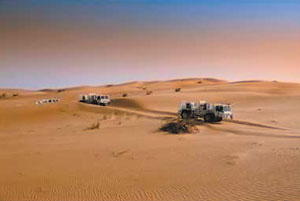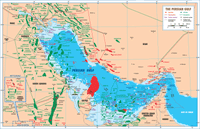|
Aug.
2001 Vol. 222 No. 8
International Outlook
|
MIDDLE EAST
Dr. A. F. Alhajji, Contributing Editor,
Boulder, Colorado
Yemen
Despite pipeline explosions, kidnapping and political
instability, small oil companies are still pouring in. Government information shows that 23 firms were working
in Yemen in 2000.
Higher oil prices and higher production led to a 98%
increase in oil revenues ($1.912 billion) that led to impressive 6.5% economic growth last year. The IMF is
pleased with Yemen’s steps toward reform and is predicating 2.4% economic growth this year.
In a surprising move, Nimir Petroleum abandoned its
operations last December, leaving all its facilities and equipment to the Yemeni government. This included a
major pipeline. It is unclear why the company resorted to this radical action.
Exploration. Yemen had been divided into 59
exploration blocks. However, the new border demarcation with Saudi Arabia added four more blocks – 57,
58, 59, and 60 – to make the total 63 blocks. A recent contract was signed between Yemen and two
companies – one Australian and the other Kuwaiti – to explore the first offshore block offered for
investment.
Agip Yemen completed 684 mi (1,100 km) of seismic in
Blocks 2 and 3, in partnership with Algerian state company Sonatrach. During 2000, Hunt Oil pursued a program
to sustain production in Block 18 (Marib-Jawf) and carry out exploration in the whole concession area. Seven
exploration wells were planned during first-quarter 2001.
In July 2000, UK-based Dove Energy struck the Sharyof 1
discovery in Block 53 that encountered a 35-ft oil layer and produced 5,000 bopd. Dove followed up with
Sharyoof 2 at 16,000 bopd, one of the most significant discoveries seen in Yemen, to date.
Four exploration wells were drilled by Vintage
Petroleum in Block S-1 in central Yemen. The first, An-Naeem 1, tested up to 48 MMcfgd and 1,265 bcpd. The
second, An-Naeem 2, flowed 27.7 MMcfgd and 880 bcpd. A third well, Harmel 1, yielded combined production from
three zones of 180 to 470 bopd. The last well, Fordus 1, was a dry hole in December. Gallo Oil and Pertacal
Energy also plugged and suspended Daw’an 2 in Block R-2, after the well failed to recover appreciable
oil.
Two wells were drilled last year by Norwegian
independent DNO in Block 32, Tasour 4 (2,500 bpd of 29°API oil) and a dry hole at Tasour D. Production
began at Tasour field last November, and Tasour 5 (7,000 bopd) was completed and tied into the central
production facility this year. The Block 32 partnership planned to conduct 68 mi (110 km) of 2-D seismic in
2001 and drill at least one development well.
Drilling / development. Last year’s
drilling level is set to increase in 2001. Of 80 exploration and development wells drilled in 2000, less than
10 were dry. The Oil Ministry expects 21 exploration wells to be drilled in 2001, in addition to 69
development wells in producing areas.
Nexen signed an MOU with the government for new Block
59 and invested $113 million in the country last year, most of it in the producing Masila Block. Nexen added
42 million bbl of reserves in 2000, at a cost of $2.68/bbl.
 |
|
Nexen gathered 2,500 km (1,554 mi) of 2-D
seismic on six parcels in southern Yemen last year. The firm this year will acquire up to 2,250 km
(1,398 mi) of 2-D seismic over 23 million acres in seven exploration licenses, and drill up to three
wildcats. (Photo courtesy of Nexen Inc.) |
|
Yemen’s LNG project is scheduled to complete in
2003, after it was delayed because of weak demand during the Asian economic crisis. Initially, all LNG will be
exported to India.
Production. Yemeni oil output increased 11% in
2000, averaging 436,000 bpd. Production increased from 431,000 bpd in first-quarter 2000 to 456,000 bpd in the
fourth quarter. It is expected to gain 1% this year, to average 440,000 bopd. Oil is produced from six field
complexes.
 |




